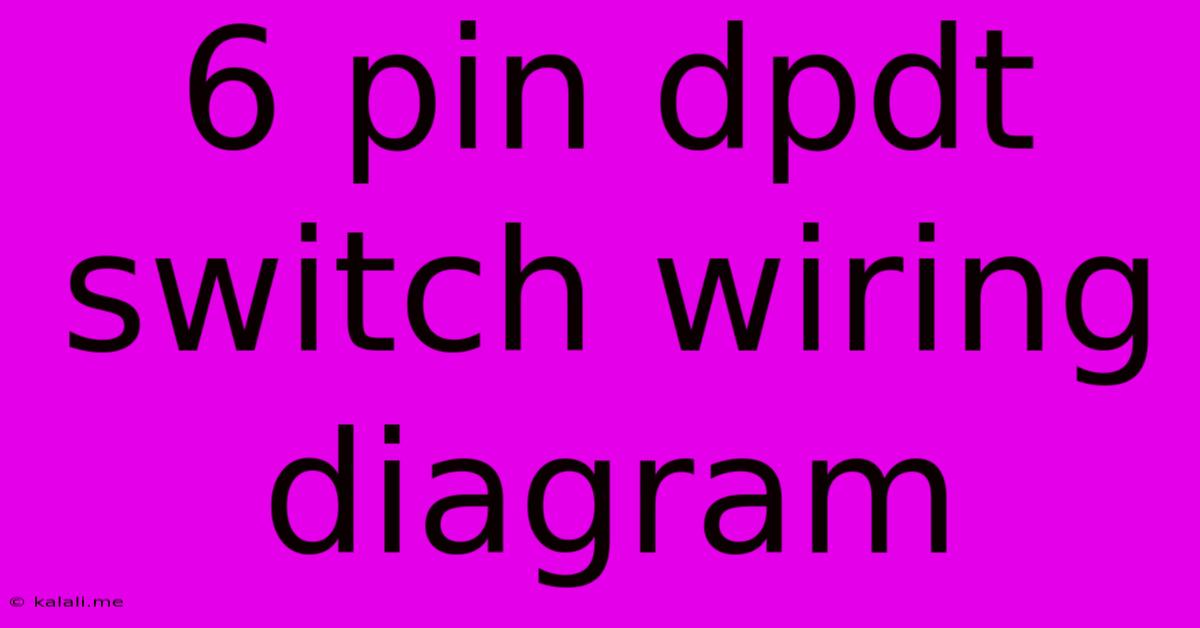6 Pin Dpdt Switch Wiring Diagram
Kalali
Jun 09, 2025 · 3 min read

Table of Contents
Decoding the 6-Pin DPDT Switch: Wiring Diagrams and Applications
A 6-pin Double Pole Double Throw (DPDT) switch is a versatile component used in various electrical and electronic projects. Understanding its wiring diagram is crucial for proper functionality. This article will delve into the intricacies of the 6-pin DPDT switch, exploring its wiring configurations, common applications, and troubleshooting tips. This guide provides a comprehensive understanding to help you confidently integrate this switch into your projects.
What is a DPDT Switch?
A DPDT switch, at its core, is a switch that controls two independent circuits simultaneously. The "double pole" refers to the two independent circuits, while "double throw" indicates that each pole can be switched to two different positions. This contrasts with a single-pole single-throw (SPST) switch which only controls one circuit in an on/off manner, or a single-pole double-throw (SPDT) switch which controls one circuit between two positions. The 6 pins represent the connections for these two poles and their respective throws.
Understanding the 6-Pin Configuration
The six pins on a DPDT switch are arranged in a specific manner. While the physical arrangement may vary slightly between manufacturers, the functionality remains consistent. Typically, you'll find the pins arranged in two sets of three, often visually separated. Each set of three corresponds to one pole of the switch.
- Pole 1: This pole has three connection points: Common (COM1), Throw 1 (T1), and Throw 2 (T2).
- Pole 2: This pole also has three connection points: Common (COM2), Throw 1 (T1), and Throw 2 (T2).
Common Wiring Diagrams
Several wiring configurations are possible with a 6-pin DPDT switch, depending on the desired functionality. Here are a few examples:
1. Simple On/Off Control of Two Separate Circuits:
This is one of the most basic applications. Each pole controls a separate circuit.
- COM1 connects to power source for Circuit 1.
- T1 connects to the load for Circuit 1.
- T2 remains unconnected (or grounded depending on the application) for Circuit 1.
- COM2 connects to power source for Circuit 2.
- T1 connects to the load for Circuit 2.
- T2 remains unconnected (or grounded) for Circuit 2.
In this configuration, throwing the switch to one position activates Circuit 1, and throwing it to the other position activates Circuit 2.
2. Reversing Polarity:
This configuration can be useful for applications requiring polarity reversal, such as motor direction control.
- COM1 connects to positive power.
- T1 connects to the positive terminal of the load.
- T2 connects to the negative terminal of the load.
- COM2 connects to the negative power.
- T1 connects to the negative terminal of the load.
- T2 connects to the positive terminal of the load.
Switching positions reverses the flow of current through the load, reversing its operation.
3. More Complex Applications (e.g., Bi-Directional Switching):
The DPDT switch can handle more complex scenarios, such as bi-directional switching, where a load needs to be switched between two different power sources or circuits. These configurations would involve connecting the common terminals to different power sources and the throws to the load terminals, creating more intricate control over the electrical flow.
Troubleshooting Tips
If your DPDT switch isn't functioning correctly, consider these troubleshooting steps:
- Check the continuity: Use a multimeter to verify connections between the pins and ensure continuity in the desired positions.
- Inspect for loose connections: Ensure all wires are securely connected to the switch terminals.
- Verify power source: Ensure the power source is functioning correctly.
- Test the load: Check if the load itself is functioning properly.
Conclusion
The 6-pin DPDT switch offers a wide range of applications due to its ability to control two circuits simultaneously. Understanding its wiring diagrams is essential for implementing its diverse functionalities effectively. With careful planning and a methodical approach to wiring and troubleshooting, the DPDT switch can be a powerful asset in your electronic projects. Remember to always prioritize safety and use appropriate safety measures when working with electricity.
Latest Posts
Latest Posts
-
Is It Legal To Tie Two Breakers Together
Jun 09, 2025
-
Java Lang Null Pointer Exception Minecraft
Jun 09, 2025
-
Best Way To Ping Device Every Few Seconds
Jun 09, 2025
-
Installing A Water Line To Fridge
Jun 09, 2025
-
What Happens If A Body Is Parallel For Too Long
Jun 09, 2025
Related Post
Thank you for visiting our website which covers about 6 Pin Dpdt Switch Wiring Diagram . We hope the information provided has been useful to you. Feel free to contact us if you have any questions or need further assistance. See you next time and don't miss to bookmark.